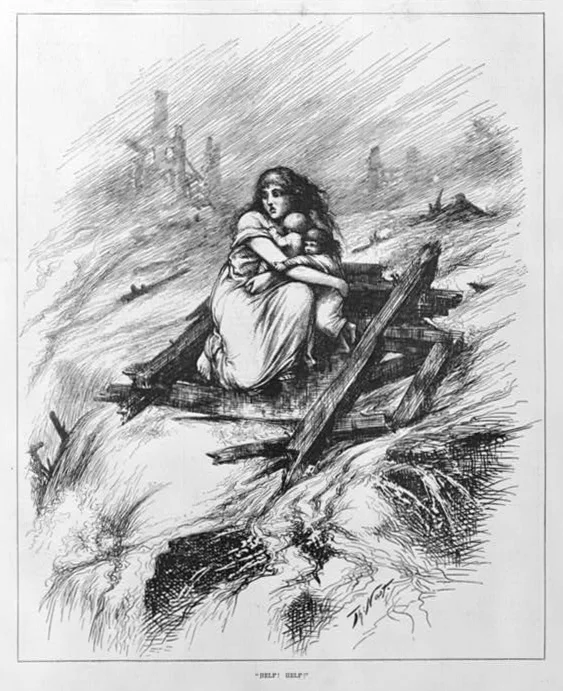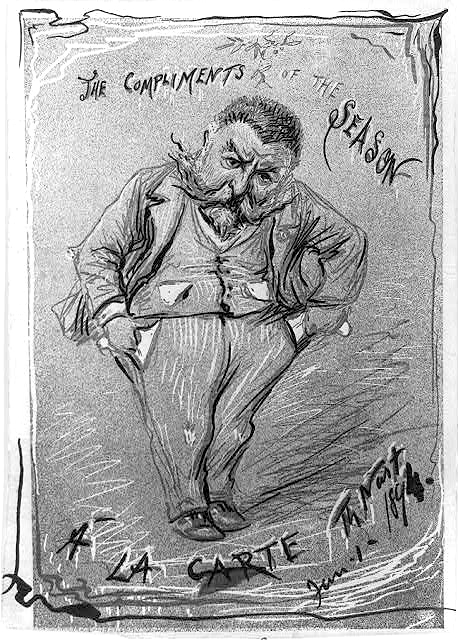Thomas Nast: His Period and His Pictures by Albert Bigelow Paine. Published by The Macmillan Company, New York and London in 1904. 583 pages and over 425 illustrations. Available via Google Books.
This is part eight of a series of posts about Paine's biography of the caricaturist Thomas Nast and research I did spurred on by reading the book. - DonkeyHotey
The Nast family takes a trip to Europe visiting old friends, sightseeing and attending the Paris Exhibition. While he was traveling, a scandal breaks that puts a tragic punctuation mark on the 1876 election.
In 1878 it was revealed that operatives of the 1876 presidential campaign of Democrat Samuel J. Tilden had attempted to purchase the votes of electors in Florida, South Carolina, and Oregon. All these transactions were agreed to, but did not succeed because they were poorly executed. The bribes amounted to hundreds of thousands of dollars. The communications to arrange this election fraud was conducted over telegraph wires using code or cyphers. This subterfuge came to light when the person who copied the cyphers delivered them to the New York Tribune and the Senate. The artist commemorated the revelations of the Cipher Dispatches in a number of cartoons including this one titled “Cipher Mumm(er)y”.
The 1876 election that the Democrats tried to steal was contested by those same Democrats after they lost. They refused to accept the election results. Then they refused to accept the conclusion of a special Commission they created. This forced a crisis and a compromise before Rutherford B. Hayes could be inaugurated that resulted in troops leaving the South and bringing on 90 years of Jim Crow.
Thomas Nast had achieved financial security with earnings from Harper's Weekly and income from Government securities, but Nast could not rest. He was feeling frustrated with his level of free expression at Harper's. The new Harper family managers gave him resistance to certain ideas. He wanted to have his own newspaper and decided to try and raise the money to accomplish that. He could not talk investors into backing him so he decided to exchange his sixty-thousand in safe Government securities for a mixed bag of potentially higher earning investments. He would later discover that he made bad choices and was taken advantage of.
Nast was not enthusiastic about supporting the Presidential hopes of Republican James Garfield in 1880. He did not use his cartoons to help the Republican ticket in the same way he had in the past. This angered friends and fans. Garfield had been one of the participants in the “Credit Mobilier” scandal Nast had criticized in his work including, “Every Public Question With An Eye Only To The Public Good”. Garfield was assassinated in his first year in office. The artist memorialized the event with “After All”.
The son of former President Grant was involved in an investment company, Grant & Ward. In 1883 Nast followed Grant's lead by investing with the company. It turned out to be a ponzi scheme. This was before this particular type of fraud had a name. Grant invested his entire life savings and Nast sold a home he owned in Harlem for thirty thousand dollars and invested that. The investment house of Grant & Ward failed in May of 1884. Nast and Grant were both big losers, but Grant was even more so. He had been convinced by Ward to approach W.H. Vanderbilt and take out a $150,000 loan to help forestall the failure. Not only had Grant lost his savings, but now he had to give all his possessions to Vanderbilt. This included all the medals, trophies, and collectibles he had gathered from around the world. Before President Chester Arthur died in 1886 he signed a bill “putting General Grant on the retired list, with full pay, so that he might want for nothing during his few final days.”
Harper's was using less of Nast's work for many reasons including reduced reader interest in public affairs and difficulty agreeing on subject matter. Nast submitted his letter of resignation on March 16 1883. It was arranged that he would stay on his $5,000 retainer for the year, but not produce cartoons for Harper's. The retainer also precluded him from offering his work to competing publications. He went to England again for a while and then returned to his family in Morristown. The Nasts entertained the Grants in their home. They enjoyed an enduring friendship and respect. Thomas and Sarah Nast went on a second honeymoon to Niagara Falls. In September, J. Henry Harper took over Harper's Weekly. J. Henry arranged for Nast to make a come back. A lingering illness delayed his return. In December, a Christmas image that was on file was published with an announcement of the artist's imminent return. It actually took two months for Nast to recover and take up his old cudgel.
He came back strong on March 1, 1884 with a cartoon titled “Help! Help!” about the desperate need of Cincinnati following a devastating flood and it's aftermath. His next effort was “Sacred Elephant”.
Theodore Roosevelt appeared in a Nast cartoon along with reform minded New York Governor Grover Cleveland. The work is titled “Reform Without Bloodshed” and was published on April 19, 1884.
The campaign of 1884 found Nast and Harper's supporting an alternative to the presumptive Republican nominee, James G. Blaine. Paine describes it as the second great “Campaign of Caricature”.
The 1884 Presidential campaign between Republican James G. Blaine and Democrat Grover Cleveland was considered a vicious contest. The “New Mulligan Letters” exposed Blaine as another corrupt politician in the pocket of Banks and Railroads. This did not diminish Blaine's popularity. Grover Cleveland was supported by Republican Mugwumps who deserted their party in opposition to Blaine.
The caricaturists readied their pens for the task at hand. They were more skilled and more numerous now with the competition not only from Frank Leslie's Illustrated Newspaper, but from cartoon magazines Puck and Judge. Harper's and Puck supported Cleveland while Judge and Leslie's favored Blaine. At Harper's Weekly, Nast worked with A.R. Waud and others. Puck was lead by publisher and caricaturist Joseph Keppler. His team included Bernhard Gillam, Friedrich Graetz, Frederick Burr Opper and others. Paine points out that “Bernhard Gillam's 'Tattooed Man' will be long remembered.” Judge featured the work of Grant Hamilton and Frank Beard.
Grover Cleveland won by a narrow, but uncontested, margin. Thomas Nast and Harper's Editor George William Curtis lost many friends and supporters in their first effort against a Republican Presidential candidate. Harper's lost circulation and advertising revenue.
The artist contributed his annual Christmas illustrations to Harper's on December 20, 1884. That year Santa was presented on a full page listening to a telephone while another full page shows a little girl speaking to him on the other end of the line. The pair was titled “Hello! Santa Claus!” and “Hello! Little One!”
Ulysses S. Grant died on July 23, 1885. Nast paid tribute to the man he admired on August 1, 1885 with a work titled, “The Hero of Our Age, Dead!”
The caricaturist produced no new work in 1887. He took time to do some traveling with friends and then with family. Erastus Wiman invited a band of artists on a cross Canada train trip. The travelers included Keppler, Gillam, Nast and others. Mr. and Mrs. Nast took a trip to the Nation's Capitol and from there went on to Florida and then home by steamer. In another vain attempt to fund a Newspaper venture, Nast invested in a Western mine. Thomas, Jr. was sent out west to manage the investment. He determined that all his investment had been wasted. This caused him to become sick and probably modified with guilt and shame at his foolishness.
He traveled to Denver to recover and there prepared to conduct another lecture tour with son Thomas, Jr. as road manager. The team made their way up the coast through Oregon and Washington before returning to Morristown. He traveled for a time with some railroad men who had the power to name a mountain after the artist. Mt. Nast is now part of the White River National Forest in Colorado. The tour was not highly profitable, but they were entertained by admirers in many cities along the way.
The cartoonist supplied art to the Democratic Committee for the campaign of 1888, Grover Cleveland v. Republican Benjamin Harrison. Cleveland lost. This was the first Presidential candidate Nast supported that did not win. Another embarrassment for the soldier of newsprint was the insult that the Democratic Committee did not pay their bill in full.
During 1889 and 1990 he did illustrations for a series of publications including the Daily Graphic, Time, Colliers, Illustrated American and others. The pay and the audience were not ever as large as he enjoyed at Harper's. In March 1892 Nast went to work for the New York Gazette. He performed his work and was rewarded with the paper itself in lieu of unpaid fees when the operation went bankrupt. He mortgaged his home to fund the project, but it closed in less than a year. Demand for his work began to drop off precipitously.
He received a two commissions to produce paintings while looking for work in Europe. H. H. Kohlsaat paid Nast $10,000 to paint "Peace in Union" depicting the scene when General Robert E. Lee surrendered to General Ulysses S. Grant at Appomattox in 1865. Kohlsaat donated the painting to the city of Galena, Illinois in 1895 at a ceremony attended by Nast.
The Shakespearean actor, Henry Irving, "knowing Nast's love of Shakespeare, invited him to make a painting which would convey his devotion to the immortal dramatist." The result of this effort was the painting titled “The Immortal Light of Genius” “...was completed on Shakespeare's birthday, April 23, of 1896, and was presented to the William Winter Memorial on Staten Island.” - Page 547
Nast received a third commission for a painting from William L. Keese commemorating the actor William E. Burton as a specific character he portrayed, “Toodles”. Keese donated the work to the Player's Club.
Thomas Nast began his career as an illustrator in 1856 at Frank Leslie's Illustrated Newspaper and ended his career on Christmas 1901 when Frank Leslie paid him to contribute a piece for the holiday edition.
Nast visited Theodore Roosevelt when he was president of the police board to compliment him on his performance. Roosevelt in turn said, “Well, Nast, I ought to be a good official. I learned my politics from your cartoons.”
In March of 1902, when Roosevelt was President of the United States, he offered Nast the post of Consular to Ecuador. On July 1, 1902 he sailed for Ecuador to earn his approximate $4,000 annual salary. In Ecuador he conducted himself as Consular in a manner that represented his country well. He wrote many letters home and read the encyclopedia. He lived in less than comfortable conditions for a man of his age and was struck down by the Yellow Fever.
Thus ended the remarkable life of the “Father of the American Cartoon.” In his career he produced more than 3000 pictures and created icons and imagery we still use today. He was a loving husband and father. He was a friend to Presidents and bohemian egocentrics alike. Thomas Nast came to America with very little and through talent, hard work and luck played a commanding role in the U.S. Politics from the Civil War through the Gilded Age.
MORE - Thomas Rowlandson




